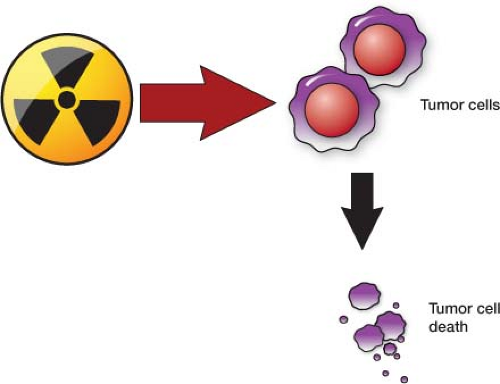Radiation Therapy
Targeted radiation has become a valuable tool in treating both cancer and the pain caused by cancer. Roughly 50% of all cancer patients will receive radiotherapy at some stage during the course of their illness. Radiation therapy works by damaging the DNA of cancerous cells via both an indirect and direct action. The indirect action occurs as a result of ionizing water surrounding the cancer cells, which forms free radicals. These free radicals then damage the cellular DNA of both cancer and normal cells (Fig. 18-1). Cancer cells have a diminished ability to repair this sublethal damage compared to healthy differentiated cells, making them more prone for targeted cell death. Advanced solid tumors—whose blood supply is limited because of constriction of local blood vessels—often have less fluid to be ionized into free radicals, making the indirect action of radiation therapy less effective. The direct action occurs via a high linear energy transfer direct to cells in the path of the beam, causing a sublethal damage to cellular DNA (Fig. 18-2).
Patients most commonly receive radiation through an external linear accelerator (Fig. 18-3). The linear accelerator uses electricity to form a stream of fast moving subatomic particles. By subjecting charged particles to a series of oscillating electric potentials along a linear beam line. In microseconds, the device moves stationary electrons to nearly the speed of light —186,000 miles a second. When these high speed electrons are fired they release a stream of photons that can be aimed to a specific part of the body. It is possible to change the radiation beam to different amounts to provide the desired tissue penetration. The amount of radiation used is measured in gray units (Gy) and the total dose varies depending on the type and stage of cancer being treated. Treatment often lasts less than 5 minutes and is not painful.
Each type of tumor carries its own sensitivity to radiation therapy. Tumors known to be especially radiosensitive include leukemias, most lymphomas, and germ cell tumors. Tumors known to be especially radioresistant
are renal cell cancer and melanoma. Size is also a significant factor, as very large tumors do not respond as well as smaller tumors to radiation therapy.
are renal cell cancer and melanoma. Size is also a significant factor, as very large tumors do not respond as well as smaller tumors to radiation therapy.
When to use
Pain from a Solid Tumor
Solid tumors cause pain by invasion, obstruction, distension, or compression of surrounding tissue or nerves. They also can cause pain by secreting inflammatory mediators. Radiation therapy is used to treat localized solid tumors, such as cancers of the brain, breast, or cervix. One challenge in treating solid tumors with radiation is that the microenvironment of solid tumors is hypoxic compared to normal tissue, and this hypoxia is associated with decreased radiosensitivity. Lack of hydration decreases the indirect action of radiation therapy.
Pain from Bone Metastases
The most common cause of pain in cancer patients is bone metastasis. Seventy percent of patients with bone metastasis have bone pain, which is caused by the tumor stretching the periosteum (membrane that lines the outer surface of all bones). Pain is also caused by nerve irritation in the endosteum (tissue lining the medullary cavity of the bone). Understanding of the mechanism of metastatic bone lesion pain is limited, because more than 25% of patients with bone metastasis are pain free and patients with multiple bone metastases typically report pain in only a few of the areas where they have lesions. Cancers that tend to metastasize to bone originate from the breast, lung, thyroid, kidney, and prostate. The ribs, pelvis, and spine are normally the first bones to which cancer metastasizes. Pathologic fractures are common in breast cancer because of the lytic nature of the lesions.
Stay updated, free articles. Join our Telegram channel

Full access? Get Clinical Tree










